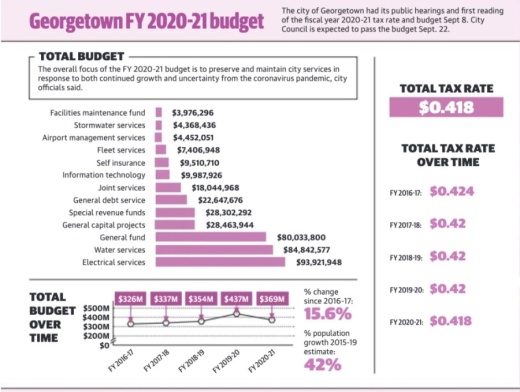The budget totals $396 million and decreases the city’s property tax rate by $0.002, making it the lowest of all cities in the Austin area with a population greater than 20,000, a news release said, adding as a result of the lower tax rate and a decline in the average taxable value of homestead properties, the average Georgetown homeowner is expected to pay lower property taxes next year.
The FY 2020-21 budget incorporates feedback received from multiple council discussions as well as a public engagement survey in June. Of the more than 650 residents who took the survey, the majority:
- did not support changes to property taxes or user fees;
- rated the value of city services and the city’s efforts to address the impacts of growth as “good"; and
- supported increased funding to manage traffic and infrastructure/roads.
The budget takes a conservative outlook for the next fiscal year, with the overall budget coming in 10% lower than the adopted FY 2019-20 budget. The general fund, which pays for several, critical services such as public safety, streets, library services, and parks and recreation, will increase by 3.7%—lower than the city’s 7.2% population growth, staff said.
The adopted budget did not change from the proposed budget, which is provided online at http://finance.georgetown.org. The adopted budget book will be available this fall, according to the release.
Other highlights in the adopted budget include the following:
- 15.5 new positions, including staff for Fire Station No. 7 and two police officers;
- 14 frozen positions, for at least part of the year;
- $1 million in cuts to department budgets, including less funding for training, travel, and supplies;
- competitive employee compensation and benefits, including market and merit raises for non-civil service employees, and market increases and annual step for public safety employees;
- $77.4 million in capital improvement projects, including investments in transportation, water and wastewater, electric and the public safety complex;
- council discretionary funds for one-time uses, including small-area plan development for the Track, Ridge, Grasshopper and San Jose neighborhoods;
- initiating design for improvements to D.B. Wood Road, the last, large project from the 2015 bond; and
- increased sanitation rates to help pay for increased costs with Texas Disposal Systems, reconstruction of the transfer station and improvements to the household hazardous waste program.
Additionally, the city is working with a contractor to study the costs to provide water and wastewater service and will likely recommend rate increases as a result.





